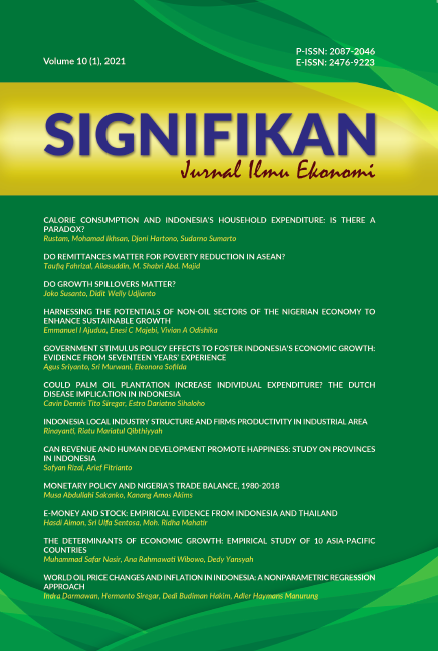Government Stimulus Policy Effects to Foster Indonesia's Economic Growth: Evidence from Seventeen Years' Experience
DOI:
https://doi.org/10.15408/sjie.v10i1.15480Keywords:
government expenditure, private spending, export, import, corruption, long run, and short-run effect.Abstract
We study the budget stimulus effects and government spending to help foster the recovery of Indonesia's current economic growth that was hit by the monetary crisis 1997 and 2008. Using government spending allocation policies through capital expenditures, infrastructure expenditures, financing through government debt, private debts, and increased productivity through export and import activities. This research provides to proves the extent to which macroeconomic variables could promote Indonesia's economic growth due to the crisis—using quantitative analysis of time series in the analysis of cointegration autoregressive distribution lag and bounds testing cointegration starting from 2001 Q4 to 2018q4 data. We can prove that in the short term, the most influential factor in economic growth is the first lag of the GDP growth itself; The first lag of exports, and the first lag of government spending and imports. However, some factors still negatively affect corruption control, government effectiveness, and government debt. While in the long term, government expenditure and imports still have a positive effect, but corruption control is still hurt GDP.
JEL Classification: G18, O47
How to Cite:
Sriyanto, A., Murwani, S., & Sofilda, E. (2021). Government Stimulus Policy Effects to Foster Indonesia's Economic Growth: Evidence from Seventeen Years' Experience. Signifikan: Jurnal Ilmu Ekonomi, 10(1), 63-76. https://doi.org/10.15408/sjie.v10i1.15480.
References
Afonso, A., & Aubyn, M. S. (2019). Economic Growth, Public, and Private Investment Returns in 17 OECD Economies. Portuguese Economic Journal, 18(1), 47-65.
Aizenman, J., & Marion, N. P. (1993). Macroeconomic Uncertainty and Private Investment. Economics Letters, 41(2), 207-210.
Akram, N. (2015). Is Public Debt Hindering the Economic Growth of the Philippines?. International Journal of Social Economics, 42(3), 202-221.
Amidu, A. R. (2016). The Causal Relationship Between Private Housing Investment and Economic Growth. International Journal of Housing Markets and Analysis, 9(2), 272-286.
Amusa, K. (2019). The Effectiveness of Government Expenditure on Economic Growth in Botswana. African Journal of Economic and Management Studies, 10(3), 368-384.
Atabaev, N., Ganiev, J., & Alymkulova, N. (2018). Crowding-out (or-in) Effect in Transition Economies: Kyrgyzstan Case. International Journal of Development Issues, 17(1), 102-113.
Azam, M., Khan, A. Q., & Bakhtyar, B. J. P. (2017). Surveying Sources of Economic Growth: Empirical Evidence From Malaysia. Problems and Perspectives in Management, 15(4), 114-123.
Cavalcanti, C. B., Marrero, G. A., & Le, T. M. (2014). Measuring the Impact of Debt-Financed Public Investment. Policy Research Working Paper No. 6766. Washington: World Bank.
Chotia, V. (2018). Infrastructure Financing and Economic Growth in India: an Empirical Investigation. Journal of Financial Management of Property and Construction, 23(3), 258-273.
Da Rocha, F. V., & Saes, M. S. M. (2018). Private Investment in Transportation Infrastructure in Brazil: The Effects of State Action. Revista de Gestão, 25(2), 228-239.
Dawson, J. W. (2006). Regulation, Investment, and Growth Across Countries. Cato Journal, 26(3), 489-509.
Deok-Ki Kim, D., & Seo, J. S. (2003). Does FDI Inflow Crowd Out Domestic Investment in Korea?. Journal of economic studies, 30(6), 605-622.
Dreger, C., & Reimers, H. E. (2016). Does Public Investment Stimulate Private Investment? Evidence for the Euro Area. Economic Modelling, 58, 154-158.
Erenburg, S. J. (1993). The Real Effects of Public Investment on Private Investment. Applied Economics, 25(6), 831-837.
Greene, J., & Villanueva, D. (1991). Private Investment in Developing Countries: an Empirical Analysis. Staff papers, 38(1), 33-58.
Khanna, R., & Sharma, C. (2018). Do Infrastructure and Quality of Governance Matter for Manufacturing Productivity? Empirical Evidence from The Indian States. Journal of Economic Studies, 45(4), 829-854. https://doi.org/10.1108/JES-04-2017-0100.
Mauro, P. (1995). Corruption and growth. The Quarterly Journal of Economics, 110(3), 681-712. https://doi.org/10.2307/2946696.
Murova, O. (2017). Public Investments, Productivity, and Economic Growth. International Journal of Productivity and Performance Management, 66(2), 251-265.
Muthu, S. (2017). Does Public Investment Crowd-out Private Investment in India. Journal of Financial Economic Policy, 9(1), 50-69.
Nguyen C. T. (2018). The Impacts of Public Investment on Private Investment and Economic Growth. Journal of Asian Business and Economic Studies, 25(1), 15-32.
Ning, Y., Xu, G., & Long, Z. (2019). What Drives Venture Capital Investments in China?. Chinese Management Studies, 13(3), 574-602. https://doi.org/10.1108/CMS-07-2017-0193.
Pesaran, M. H., Shin, Y., & Smith, R. J. (2001). Bounds Testing Approaches to the Analysis of Level Relationships. Journal of Applied Econometrics, 16(3), 289-326.
Romer, P. M. (1994). The Origins of Endogenous Growth. Journal of Economic Perspectives, 8(1), 3-22.
Sabir, S. (2019). Fiscal Policy, Institutions, and Inclusive Growth: Evidence from The Developing Asian Countries. International Journal of Social Economics, 46(6), 822-837. https://doi.org/10.1108/IJSE-08-2018-0419.
Sabry, M. I. (2015). Good Governance, Institutions, and Performance of Public, Private Partnerships. International Journal of Public Sector Management, 28(7), 566-582. https://doi.org/10.1108/IJPSM-01-2015-0005.
Sasmal, R. (2016). Public Expenditure, Economic Growth, and Poverty Alleviation. International Journal of Social Economics, 43(6), 604-618. https://doi.org/10.1108/IJSE-08-2014-0161.
Scott-Joseph, A., & Turner, T. F. (2019). Does the Composition of Government Expenditure Matter for Eastern Caribbean Economies’ Long-run Sectoral Output Growth?. International Journal of Development Issues, 18(1), 2-14. https://doi.org/10.1108/IJDI-01-2018-0011.
Shrestha, M. B., Bhatta, G. R. (2018). Selecting appropriate methodological framework for time series data analysis. The Journal of Finance and Data Science, 4(2), 71-89.
Spilimbergo, A., Symansky, S., Blanchard, O., & Cottarelli, C. (2008). Fiscal Policy for the Crisis. IMF Staff Position Note, SPN/08/01. Washington: International Monetary Fund.
Voss, G. M. (2002). Public and Private Investment in the United States and Canada. Economic Modelling, 19(4), 641-664. https://doi.org/10.1016/S0264-9993(00)00074-2.
Zhang, D. (2015). Public Investment in Agricultural R&D and Extension. China Agricultural Economic Review, 7(1), 86-101. https://doi.org/10.1108/CAER-05-2014-0052.

